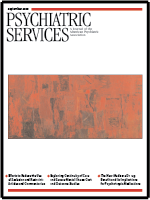Diagnostic Stability Four Years After a First Episode of Psychosis
Abstract
OBJECTIVE: The objective of this study was to determine the stability of a diagnosis of psychosis four years after the first-episode diagnosis. METHODS: The study was a prospective four-year follow-up study (1995 to 1999) of 147 patients with schizophrenia, affective disorder, and other psychoses who presented with a first episode of psychosis in an epidemiologic catchment area in Ireland. All diagnoses were made on the basis of the Structured Clinical Interview for DSM-IV. RESULTS: One quarter of the patients evidenced a change in diagnosis at follow-up. The most common change was to a diagnosis of schizophrenia. The positive predictive values of schizophrenia and bipolar affective disorder were 97 percent and 80 percent, respectively. Fewer years spent in education, lower levels of initial psychopathology, and presence of comorbid alcohol or substance abuse were associated with change in diagnosis at follow-up. CONCLUSIONS: Among the diagnoses studied, schizophrenia was the most stable diagnosis after four years. The greatest instability occurred in the categories of drug-induced psychosis and psychosis not otherwise specified.



